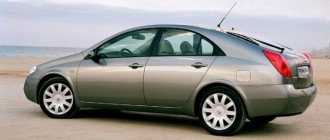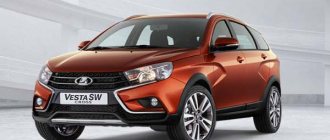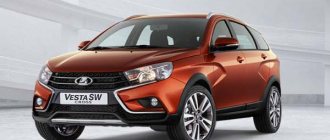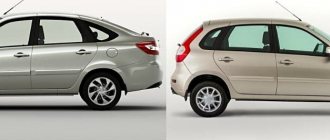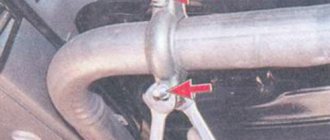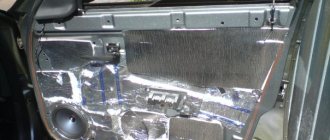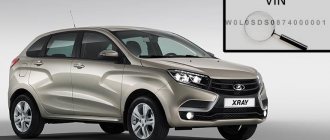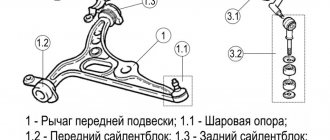Liftback
A liftback is a type of closed car body that is intermediate between a sedan, station wagon and hatchback. It differs from the hatchback in the longer rear overhang: the liftback has the same length as the sedan. The rear part of the roof can be either sloping or (less often) stepped, reminiscent of a sedan.
Body type Liftback
SUV
SUV or SUV - Sport Utility Vehicle
- a type of car with increased cross-country ability and increased ground clearance. The SUV (jeep) is distinguished by its impressive dimensions, all-wheel drive and reduction gear. Essentially, an SUV is a station wagon suitable for off-road use. Often an SUV has a frame body.
Separately, crossovers
, or “SUVs” - this is how cars are often called whose driving properties do not allow them to be classified as “real” SUVs. The crossover combines the properties of a jeep and a station wagon (hatchback); it is more modest in size compared to an SUV, and its ground clearance is lower. Recently, the popularity of crossovers has been growing rapidly.
Four-door coupe
Recently, a lot of cars have begun to appear on the market, which, in fact, blur the standard for classifying sedans and coupes. We are talking about coupe cars that have four doors.
For example, BMW 6 Series Gran Coupe, BMW 4 Series Gran Coupe, Audi A5 Sportback, and Mercedes-Benz CLS. All of these cars should be classified as four-door coupes.
Why were such cars brought to market? Basically, the appearance of cars in the back of four-door coupes is the merit of marketers. Thus, through marketing tactics, car companies offered coupe car lovers practicality and convenience that was previously only available to four-door car owners. As a result, the designers designed four-door models made in coupe style.
This type of vehicle is a true indication that consumers have become more discerning in their tastes and more demanding of new models. Since the popularity of coupes has not been falling for a long time, and also due to the incredible popularity of crossovers and SUVs, it is logical that coupe crossovers should have appeared on the market.
This happened shortly after the appearance of the world's first modern crossovers. For example, the first company to undertake a bold experiment en masse was the BMW company, which released the four-door crossover X6 in a coupe body, which the public initially greeted with caution, but then the X6 quickly gained popularity despite criticism from experts.
Thanks to their high ground clearance, dimensions and spacious interior, four-door crossovers and coupe-style SUVs have begun to gain popularity from four-door coupe passenger cars. After all, we must admit that no one doubts the versatility and practicality of crossovers. Plus, the graceful lines of the coupe body give the SUV a luxurious appearance.
Including coupe crossovers, as a rule, they are light and powerful, unlike conventional SUVs and crossovers.
Monovolume trucks
The single-volume body does not have a far protruding hood and trunk - the engine and luggage compartment are located almost in the cabin. Single-volume bodies boast a huge number of options for transforming their spacious interiors.
“Single-volume vehicles” include the “youngest” body types: minivans, compact vans, microvans - that is, almost all buses of any size. These body options can be distinguished by the size of the car and the number of rows of seats.
Minivan.
| Minivan Ford Galaxy |
The minivan is distinguished by the most impressive dimensions (length of at least 4.5 m) and the mandatory presence of a third row of seats. Additionally, most minivans can be identified by their sliding side doors. Minivans appeared in the mid-80s and became the first representatives of “one-volume” vehicles.
Compact van.
| Ford C-MAX compact van |
The compact van is between a microvan and a minivan in size, with a length of 4.2 to 4.5 meters. However, some compact vans may have a third row of seats. The first “compacts” were released in the mid-90s. In essence, this is a slightly smaller (compact) version of a minivan.
Microvan
| Microvan Nissan Note |
A microvan is simply an increased size (height) hatchback with a more spacious interior. The microvan does not have a third row of seats. The length does not exceed 4.2 meters. The first microvans appeared only 5-7 years ago, but they are already rapidly gaining popularity in Europe and even on our roads they can be seen more and more often.
The differences are getting smaller
Gradually, the difference between the types becomes less noticeable. Just look at the Skoda Superb sedan-hatchback (the trunk lid can be opened with or without glass) or the almost one-volume Honda Civic hatchback.
The desire of manufacturers to create the most universal car will soon lead to the fact that it will be incredibly difficult to understand what type of body .
Body types
One of the most important criteria that guides the selection of a car is the body type.
The number of car body types has almost doubled over the past 15-20 years. Manufacturers are increasingly trying to combine several body types in one car. It is becoming increasingly difficult to distinguish one option from another, but we will still do it. Let's look at the classification of car body types
To begin with, we will divide all body types into 3 groups: three-volume, two-volume and single-volume.
Crossover or sedan. pros and cons.
When compact crossovers began to catch up and overtake sedans in sales volume in the new car market, heated debate broke out about the validity of this situation. Despite the fact that this situation has been going on for several years, a final answer to the question “crossover or sedan” has not yet been found. I’ll try to formulate five reasons in favor of a crossover and five in favor of a sedan, such as the Hyundai Solaris.
Crossover. More cargo space. Crossovers, like hatchbacks, are more spacious than sedans. Not only that, sometimes even with the rear seats folded down, the trunk volumes of crossovers and sedans are almost the same, but if you fold the back row, crossovers have simply a huge space for transporting anything you want. If you regularly have to transport not only people, but also a lot of things and cargo, this is an obvious plus in favor of a crossover.
Crossover. All-wheel drive is permanent or plug-in. Do you live in a region where it is not summer all year round? Snow, mud, and even roads of not the best quality? Do you like to travel and go out into nature? Well then, all-wheel drive is what you need. Although, of course, there are sedans with all-wheel drive, but for crossovers it is actually a basic requirement. In fact, if you need better cross-country ability, then you can safely look at all the crossovers on the market, and not look for a few all-wheel drive sedans, which, moreover, often cost quite an outrageous amount of money.
Crossover. Boarding of the driver and passengers. One of the reasons for the popularity of crossovers was the high seating position of the driver and passengers. A seating format that allows the driver to sit higher than in a sedan, along with reasonable fuel economy, makes crossovers more popular than old-school cast-iron SUVs. In urban environments, better visibility allows you to better see and assess your surroundings.
Crossover. Off-road. Do you often cross mountain rivers, tractor tracks and small fords? Then a full-fledged SUV is your choice. And in order to get into the forest, through muddy spring mud or a rocky area, a crossover will be more than enough. Sedans really have nothing to do here. Well, if only WRX...
Crossover. More and more great options. With the growing popularity of the crossover class, manufacturers began to offer ever richer and more interesting configurations, expanding their engine ranges and the amount of additional equipment. Which, in principle, begins to equalize them in terms of comfort and equipment with sedans.
———————————————————————————————
Sedan. Fuel economy. Although the crossover has come a long way from large SUVs that guzzle buckets of gas, and today can boast of quite interesting efficiency indicators, sedans are still more economical one way or another. On average, a sedan consumes 10-15% less fuel than a crossover.
And also interesting: Buy LADA (VAZ) Niva 2021 in Moscow, low price for Lada Niva 2021 on the Avto.ru website
Sedan. Boarding of the driver and passengers. Life is such that not everything can be measured by averages. And people are often taller than average. Which imposes certain restrictions on cars. If in most C and D class sedans a person with a height of 180 to 200 centimeters will feel quite comfortable, thanks to the reclining seating position, then in most crossovers he will need to open the hatch so as not to rest his head on the roof.
Sedan. Proven design. Proven does not mean old at all. When buying a Toyota Camry or VW Passat, we know what we are getting. For many years. But what is that same RAV4? Big Prius? Or something else? That is, most crossovers are assembled on a sedan platform. And here the question is - which is better?
Sedan. Visibility. Parking sensors almost in a circle, all-round cameras, blind spot monitoring systems and much more that have recently begun to be shoved into crossovers without limit, this is an attempt by manufacturers to compensate for not very good visibility and a sense of size (for example, the same Mercedes Benz GLA with visibility point of view is not very good). For a sedan, a rear view camera and parking sensors front and rear are often sufficient.
Sedan. Elegance and style. Mercedes-BenzCLA-class, FordFusion, KiaOptima, JaguarXF, Dodge Charger, BMW6-series GranCoupe... Continue? In principle, if you really value style in a car, a sedan has much more advantages.
- Hyundai Tucson N Line For quite a long time, sports versions of production cars were the prerogative of exclusively German ones, and well...
- The Audi e-tron is the brand's first production electric car, the world premiere of which took place in San Francisco. Full size…
- While the “cool wheels”, or rather, the photo shoot, are being stored on a flash drive until maturation in the first days of the coming week, I would like to say...
- To look at the latest Russian and foreign mass tuning, all you have to do is come to Vorobyovy Gory and everything will immediately become clear. Trends,…
- This year marks the 50th anniversary of the annual SEMA Show in Las Vegas. This has already become a traditional automobile...
- The automotive world is structured in such a way that, despite sales plans and market trends, exceptions to the rules appear from time to time, which, no matter…
- Even in its previous generation, the Ford F-150 Raptor gained considerable popularity with its aggressive appearance, powerful engine, and all that...
- When the famous Swedish car manufacturer Volvo, which at that time was not in the best shape after a break with Ford,...
- The massive gates rise in front of you and the SEMA Garage appears before your eyes. The place where powerful and famous cars are born. And the first thing...
Conclusions website
- Coupe - a body type with two doors, most often of a sporty look; The back row of seats is either missing or insufficiently spacious for an adult.
- The sedan is the most popular body type with four doors and full-size seats.
- Getting rear passengers into the compartment is inconvenient and requires people to first disembark from the front seats.
- The coupe is as comfortable as possible for the driver and front passenger.
- The trunk of a coupe is usually larger in volume than the trunk of a sedan.
- The coupe body is stronger than the sedan due to its design features.
The development of modern infrastructure has given impetus to the widespread use of various variations of passenger cars for urban traffic and intercity transportation. Hatchbacks and station wagons are especially popular among domestic consumers.
But what is the difference between a hatchback and a station wagon? And what are their advantages over “classic” sedans? In this article we will answer the most common questions from motorists.
A hatchback is a variation of a passenger car with a short overhang, a rear “hatch” door and a small luggage compartment combined with the interior. Depending on the specific configuration, the car may have 1 (less often) or 2 rows of seats, 3 or 5 doors. The luggage compartment can be significantly increased by simply folding the rear seats.
The appearance of hatchbacks was the result of the growing demand for a city car, behind the wheel of which the driver would feel comfortable in dense city traffic during rush hour. The border of the body runs along the edge of the rear wheels. The layout in most cases involves front-wheel drive with a transversely mounted engine. These solutions can significantly increase the vehicle’s maneuverability and make parking possible in difficult conditions.
A beginner who has just graduated from driving school will feel more confident in a hatchback, since the dimensions of the body are much better felt on it.
Let us once again pay attention to the characteristic distinctive features:
- Shortened rear overhang - thanks to this feature, the hatchback can be easily distinguished from other modifications in appearance;
- The trunk volume is less spacious than in station wagons or other variations;
- There is a door in the back wall. In some cases, the glass in it can open separately.
Due to the fact that the interior is actually combined with trunks, passengers may complain about an unpleasant odor emanating from the trunk if specific foods, motor oils, etc. are regularly transported there.
The main differences between a hatchback and a station wagon
Common features inherent in the hatchback and station wagon - both classes are a modified sedan with an essentially combined interior and trunk.
The differences between a hatchback and a station wagon are as follows:
- The size of the luggage compartment is significantly smaller in the Hatchback. The station wagon is excellent for cargo transportation and is often purchased by private entrepreneurs and medium-sized companies precisely for these purposes;
- The hatchback features a more elegant rear design. The inclined door looks much more beautiful than the strict vertical overhang of the station wagon. Women often make choices based on this;
- The station wagon is longer than the hatchback. This can be a significant drawback in urban environments if the car is used only for transporting passengers, but when it comes to large cargo, this is definitely an advantage;
- The hatchback can be supplied in a “sporty” 3-door configuration;
- Station wagons, as a rule, are more expensive than hatchbacks of the same series.
Both classes of passenger cars discussed in this article occupy their niche in the domestic market and are in demand among Russian motorists due to their features.
Three-volume units
Three-volume body
has a protruding hood and trunk. Three-volume vehicles are among the least versatile bodies due to the limited possibility of transforming the interior and trunk. This group includes sedans, coupes, convertibles and pickups.
Sedan, coupe.
The main difference between a coupe and a sedan is the two-door body. A coupe (from the French “couper” - to cut off) is usually built on the basis of a sedan and has a sporty bias (lower body, powerful engines). A coupe does not always have a pronounced three-volume body and is often shaped like a three-door hatchback. But a hatchback is always distinguished by its vertically positioned tailgate, which in a coupe they try to make as horizontal as possible.
Convertible, coupe-cabriolet, roadster.
A convertible is a coupe with a “soft” tent roof that folds behind the rear seats and rises if necessary.
But the soft top did not allow the car to be used all year round, so in the late 90s a new version of the open body began to gain popularity - the coupe-convertible. At first glance, it looks like a regular coupe, but when you press the right button, the hard metal roof lifts up and neatly folds into the trunk, turning the coupe into a convertible.
A two-seater convertible (without a second row of seats) is called a roadster.
Porsche Boxster Roadster Audi TTS Roadster
Pickup
.
| Mitsubishi L200 pickup |
A pickup truck is a body with an open cargo area separated from the interior by a rigid partition. Simply put, it is a smaller copy of a regular truck. Most often this body is confused with a van. In order not to be mistaken, it is enough to remember that Pick-up in English also means “to pick up”, “to pick up”, that is, to quickly throw it into the back... Most pickups are built on the same platform as SUVs and have good cross-country ability. Both here and throughout Europe, pickup trucks are not particularly popular, but in the USA they are crazy about them.
